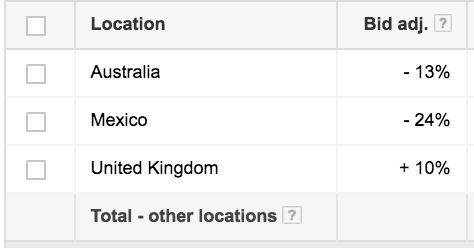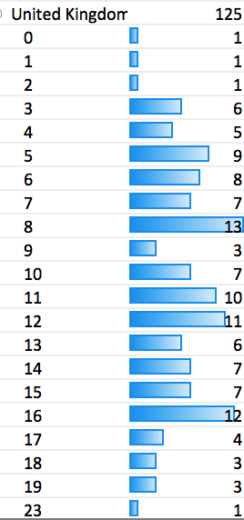Road Trip – 5 Tips For Creating International Campaigns

I just spent a week in my birthplace of Scarborough, Ontario, and I was surrounded by stories about the hometown hero Andre De Grasse and the emotional last show from the Tragically Hip and so much Justin Trudeau contemplation.

I was also immersed in very specific paid search advertising based on my IP address. I was amused that while looking at the same search queries as my US counterparts in a meeting, that the ads I saw were all about hockey gear while my Yankee friends were being served ads about baseball hats.
International markets can add complexity to any account, but here are a few settings and opportunities to make your global ad strategy stand out in non-US markets. This post is a companion piece to yesterday’s post about geotargeting, which you should read if you haven’t already. The post will follow this format.
- Account Structure and Settings
- Ad Copy
- Ad Scheduling
- Geo Targeting
- Geo Ad Customizers
Account Structure And Settings
There are 2 options for how you can structure your account in Google or Bing when you are advertising in multiple markets. You can keep your existing US campaigns and add bid modifiers for international traffic or you can create separate international campaigns. Either way, you want to make sure your campaign naming conventions have as much detail as possible and give you enough information to distinguish the following:
- Search or Display
- Location
- Language
For example, Display_Brand C_French_Quebec.
In the first example, we will examine how to set up bid modifiers using the US campaign as a guideline for what the modifier should be for Canada and the next 3 biggest international markets. With a revenue report, we can calculate revenue per session and determine what countries have the closest revenue per session rate compared to the US. With this metric, we can set the bid modifier to that exact amount, or some variation.

In this example, the client’s bid modifiers were increased by the difference in revenue per sessions between the international market and the US for Australia and Mexico, but for the UK the modifier was increased beyond the delta in revenue per session compared to the US, in an attempt to grow that sector. This structure is best suited for accounts with a small international presence, streamlined list of offerings, and strict budget.

Alternatively, another campaign structure would be to have separate campaigns for each region. Each with their own budget, ad schedule, ads, language, and reporting. This is an ideal structure for accounts with large global reach and complex product offerings.

Regardless of the structure that is selected, it is important to include and exclude the appropriate geographic areas in the advanced location settings section. Using the campaigns above, for example, in the “Search – Brands – Product A – Canada” campaign, we would exclude any traffic from people outside of Canada.

Ad Copy
Writing ads specific to the foreign market is kind of obvious – sorry, eh. But it bears repeating! Make sure you see what your competitors are writing in the same city. Should your ads be translated to the local tongue? Is there a weird quirk of the language that you should honor (or honour)? Are there holidays that you can capitalize on, such as Boxing Day in the UK? Don’t forget pretty much every other market uses the imperial system for measurements. There are ways to customize your international efforts which we will discuss these later in the article.
Translating into the local language depends on the market in question and your product. If the market has a high population of English speakers and the ad is a well-recognized brand, a simple product, or a product with a defined name or SKU, you can probably avoid having to translate. If you decide to convert your ads to the local language, make sure you hire a native speaker to write the ads in order to prevent miscommunications in messaging. Lastly, take the time to make brand new ads instead of recycling your existing text.
Ad Scheduling
The Geo report in Analytics will tell you the location of visitors and by adding a second dimension, hour of day, you can see the most popular times to advertise in each country. This information will help with dayparting and implementing bid modifiers at peak times. Just note that AdWords, Analytics, and Bing data will default to the time zone of the country where the account was created. For example, as I sit in Bloomington, Indiana in the Eastern time zone, when looking at the UK market’s hourly breakdown I can see that between 3am and 4pm in EST is the peak selling time for the UK. I should increase my bid modifiers to bid higher during this time and perhaps bid lower from 11pm – 3am.

Geotargeting
Location targeting helps concentrate your ad spend to the geographic areas that matter the most to your business. Analytics will help you decipher which geographic regions have the most activity and where you should consider increasing or decreasing your location bid modifiers. Again, reading Carrie Albright’s post from yesterday will give you a solid breakdown of how to effectively add geotargeting to your account.
Geo Ad Customizers
We are near the end of our international road trip. For those that have many markets they want to explore and not a lot of time, ad customizers are the way to go. Geo ad customizers will allow you to create a template for ads that can be copied into multiple campaigns with a message that is tailored to the location of the person typing the query. Here are the steps:
- Create a spreadsheet of the locations you want Google to replace in your ad depending on the user’s IP address and give this list a name. In the example below it is called “Geo.”
- Upload this document to the Business Data section of the Shared Library
- Add dynamic ad copy that will pull in this data, for example:

Additionally, if you add a list of location opening and closing times, you can get even fancier with ad customizers and implement a countdown to closing which will cater even further to your international audiences. For example, {=COUNTDOWN(Closing.CountdownTime)} is the string of code you would use in your ad copy to say countdown to the closing time.
Final Thoughts
Customizing your advertising campaigns for international markets requires a few additional steps but can result in more efficient budget allocation and better returns from non-US markets. Even if you aren’t considering your international business, these principles can be applied to your domestic efforts as well. Once you set up an international strategy you can sit back and relax, whether at home drinking some Starbucks or overseas with some chai.



